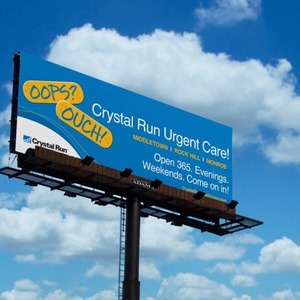From Urgent Care, to Managed Care, to “Thought Leadership,” Crystal Run Health Keeps Its Corner of the World Covered
Notable Health Care Advertising
// By Peter Hochstein //
 This somewhat complicated story starts, at least for me, with a clever graphic trick on a highway billboard.
This somewhat complicated story starts, at least for me, with a clever graphic trick on a highway billboard.
The billboard displays the word “OOPS?” in an upward-slanted, rounded rectangle. And then the word “OUCH!” in a similar but downward-slanted rectangle. Adjacent to OOPS? and OUCH! is a headline that says “Crystal Run Urgent Care!”

Words used as a visual call attention to Crystal Run’s urgent care facilities. Outdoor and radio were chosen for the urgent care advertising because “With many residents commuting to and from work each day for 30 minutes or more, they in some ways become a captive audience,” says Mark Trocino, Director of Marketing and Public Relations at Crystal Run Healthcare.
Urgent care centers are popping up a lot in city storefronts, shopping centers, and sometimes even drugstores these days. They fill a niche between the family physician, who can be difficult to see on short notice, and emergency rooms that are often crowded and costly. I was curious to know how the “OOPS?/OUCH!” advertising was working.
But a subsequent exchange of questions and answers with the people who speak for Crystal Run Healthcare, headquartered in Middletown, New York, and its advertising agency, PCI in Alexandria, Virginia, indicated that there’s a lot more to the story—and to Crystal Run. It all might be part of an emerging trend toward marketing fully integrated health care. It’s worth a closer look.

Mark Trocino, Director of Marketing and Public Relations at Crystal Run Healthcare
Mark Trocino, Director of Marketing and Public Relations at Crystal Run Healthcare, indicated that his organization covers a lot of territory, both geographically and medically. He says his organization “is a premier, multi-specialty group medical practice with more than 350 providers in 40 medical and surgical specialties, located in more than 30 practice locations throughout the Hudson Valley, lower Catskill region, Manhattan, and northern New Jersey.”
Trocino adds that Crystal Run is accredited and designated as a Level 3 patient-centered “medical home,” a term that sent me scrambling for the latest definition. The United States Department of Health and Human Services provides one, which alas is more than 1,000 words long. But the crux of it seems to be what HSS calls “a cultivated partnership between the patient, family, and primary provider in cooperation with specialists and support from the community. The patient/family is the focal point of this model.”
But there’s more to Crystal Run than even that. In two mostly rural counties, Crystal Run now offers its own health plans, which are essentially managed care insurance for businesses and individuals that compete with similar plans in those areas. Moreover, Crystal Run has hospitalists at two Hudson Valley medical centers and a community hospital. And it is part of an alliance with Mount Sinai Hospital down in New York City, which Trocino calls “a groundbreaking partnership aimed at furthering better care, better health, and lower cost.”
So how is all this reflected in advertising?
For the health plans, 30-second and 60-second television spots run at an average of 901 gross rating points for age 25-plus audiences. The spots emphasize with photography, as well as language, that Crystal Run’s “plan for better health” is local, and can “fully integrate our services with a new kind of health insurance plan.”

Frances Reimers, Director of Corporate Visibility for PCI
“The spots have run in our cable buy for Orange and Sullivan counties in New York,” shares Frances Reimers, Director of Corporate Visibility for the PCI agency. Her written replies to questions said the spots seek to “show Crystal Run’s commitment and longevity within the community as leaders in health transformation.” Meanwhile, print advertising headlines say “The New Health Plan in Town.”
To help their own physicians compete with rival medical practices, Crystal Run makes use of print advertising that turns a commonplace colloquial question into a headline: “Have you seen a doctor about that?”
One ad then answers the headline with a list of 12 local practices, their locations, and telephone numbers. The body copy promises: “More than 40 specialties, including outstanding primary care … many with walk-in or same-day appointments.”
But Crystal Run is also seeking to position itself, Trocino says, as “a thought leader and transformational force in the community.” It’s an objective supported by advertorials that bear the common theme: “On This We Can Agree.” The ads focus on outcomes and cost, but speak in everyday language.
Topics, each beginning with the “On This We Can Agree” theme included: “Your goal is more health, not more tests and procedures.” And “Healthcare should center on the patient’s needs, not the doctor’s needs.”
The advertorial was instituted because “a lot of the arcana of value-based care could be confused with controversial or unpopular aspects of healthcare reform … such as Obamacare,” Reimers says.
All the advertising is linked by what Reimers calls the “brand architecture,” which includes shared typography, a color palette, and other graphic elements. Like many health care organizations and institutions, Crystal Run declined to reveal its advertising budget.
The campaign overall “was a hit, and Crystal Run saw a double-digit increase in online requests for appointments,” according to a PCI blog post. Trocino confirms that increase. He adds that, thanks to a 2015 website redesign, traffic to the website has “increased substantially… Analytics show significantly lower abandonment stats, as well as deeper site navigation on average for our businesses.”
Should Group Practices Do Issue Advertising?
Reimers and Trocino both agree it can pay.
In Crystal Run’s case, says Trocino, instead of focusing on the group practice and providers and services, “we instead took a step back, and decided to do some consumer education as to the changing health care landscape and what health care benefits [for patients] have come of it.”
Reimers adds that the campaign “helped broaden the understanding of what Crystal Run is trying to do, and helped position them as thought leaders and disruptors in the market.”
Peter Hochstein is a direct response advertising consultant, business journalist, and author. He is the author of “Lessons from 9 Innovative Health Care Marketing Campaigns,” a white paper from SHCM, which you can download for free. Reach Peter through his website, http://peterhochstein.com.
